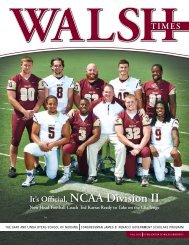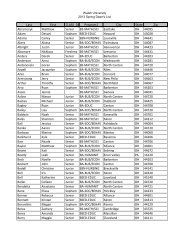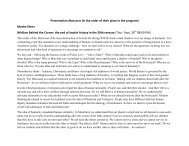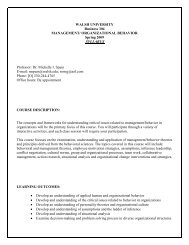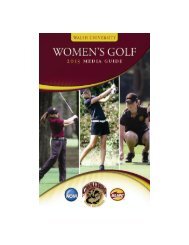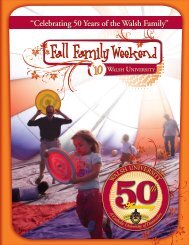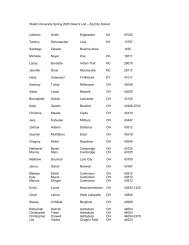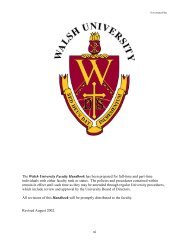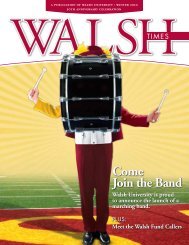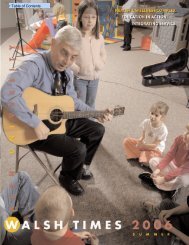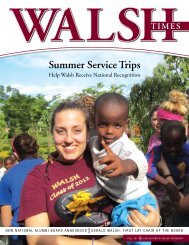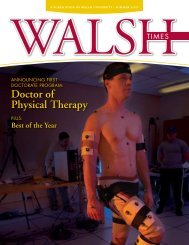Times - Walsh University
Times - Walsh University
Times - Walsh University
- No tags were found...
Create successful ePaper yourself
Turn your PDF publications into a flip-book with our unique Google optimized e-Paper software.
Green EffortsTake RootThe trees weren’t the only thing turning green this spring on <strong>Walsh</strong>’s campus.Several initiatives that were launched in the fall to promote recycling anda cleaner environment have reached fruition this summer.In December, <strong>Walsh</strong> <strong>University</strong> received a grant for $111,795 from The Herbert W.Hoover Foundation to develop, implement and disseminate a protocol for “green”– or environmentally friendly – chemistry labs procedures.“We’re eager to explore new ways to teachchemistry that do not place the environmentat risk,” said Dr. Michael Dunphy, Chair of<strong>Walsh</strong>’s Division of Math & Sciences.This summer, Drs. Neil <strong>Walsh</strong>, MichaelDunphy and Peter Tandler will beginexploring “green” variations of classic.lab experiments used in first year collegechemistry courses. These protocols canthen be translated for implementationinto the high school level.The project has been designed to involvestudents, under the supervision of trainedfaculty researchers/educators, in thedevelopment of each lab procedure. In thisway, the <strong>University</strong> can not only contributeto the field of “green” chemistry but alsoprovide valuable learning and professionaldevelopment opportunities for its students.Their work will create one of the first comprehensiveresources on this new front, and theresults of the project could easily be transferredto sister institutions across the country.This summer:• Dr. Tandler will concentrate on exploringenvironmentally safe alternatives for the toxicmetals (lead, chromium, etc.) typically used inquantitative mass relationship experiments.• Dr. Dunphy will be exploring environmentallysafe procedures in separation tacticsappropriate for first year college and highschool chemistry labs• Dr. <strong>Walsh</strong> will focus on establishingalternatives such as sugar or starch forseparation analysis in column chromatographyexperiments.With increased usage of chemicals withinthe learning and research settings comes anincreased burden on the campus to allocateresources for safe disposal. Finding alternativeways to approach the critical learninginvolved with “green” chemistry is not onlyeconomically sound but vital to long rangeenvironmental responsibility. While thefield currently has accepted protocols forthese activities, they are more concernedwith human safety than with environmentalimpact. <strong>Walsh</strong> <strong>University</strong>, with the helpof the Herbert W. Hoover Foundation, isready to make significant contributionstoward the resolution of this importantglobal issue through the development ofprotocols for green lab procedures, not onlyuseful at the college-level, but that can beadapted for high school and lower grades.Somethingto Consider:• <strong>Walsh</strong> <strong>University</strong>’s undergraduateenrollment has grown more than80% in 10 years• Every student pursuing a bachelor’sdegree must take at least one sciencecourse with a laboratory component.• That translates into more than 2,000individuals engaged in laboratorylearning experiences over the courseof any four year period.• Beyond <strong>Walsh</strong>’s campus, in the UnitedStates alone, there are nearly 2,200four-year institutions of higher education,and chemistry labs are a part of nearlyevery institution’s curriculum.The waste generated from these chemistrylearning opportunities often requiresspecial and expensive procedures forproper disposal.17



